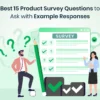Negative feedback can feel like a punch to the gut. It is easy to get defensive, but remember, negative feedback is a gift. It is a golden opportunity to learn, improve, and ultimately, strengthen your relationship with your customers. But how do you navigate these choppy waters and emerge with a brighter, more customer-centric business? Enter the customer feedback app, your secret weapon for turning frowns into smiles and preventing negative feedback before it even arises.
Customer feedback is a double-edged sword – a valuable tool for growth and a potential source of criticism. In this guide, we delve into the art of responding to negative feedback and implementing strategies to prevent it. Leveraging the power of a customer feedback software, we explore tips and tricks to turn critique into an opportunity for improvement and customer satisfaction.
Understanding the Role of Customer Feedback software:
Customer feedback apps have become indispensable tools for businesses seeking to understand and enhance the customer experience. These apps streamline the feedback collection process, offering real-time insights that can be pivotal in responding effectively to negative feedback and proactively preventing it.
Why Embrace Negative Feedback?
Negative feedback, though tough to swallow, offers invaluable insights. It reveals blind spots, highlights areas for improvement, and allows you to demonstrate your commitment to customer satisfaction. By actively listening and addressing concerns, you can:
- Turn detractors into promoters: A well-handled negative experience can be a turning point, showcasing your dedication to customer service and potentially winning back a lost customer.
- Build trust and loyalty: Openness to feedback demonstrates transparency and a willingness to learn, fostering trust and loyalty among your customer base.
- Boost brand reputation: A proactive approach to handling negative feedback can turn it into a positive PR opportunity, showcasing your commitment to customer care.
- Prevent future issues: By addressing the root cause of negative feedback, you can prevent similar issues from happening again, saving yourself time and resources.
Responding to Negative Feedback: The Art of Turning Frowns Upside Down
- Acknowledge and apologize: The most important step is acknowledging the customer’s experience and expressing sincere regret. Be empathetic and avoid defensiveness.
- Take ownership: Do not deflect blame or make excuses. Own the issue and assure the customer you are taking steps to resolve it.
- Listen actively: Show the customer you are genuinely interested in understanding their experience. Ask clarifying questions and pay attention to their emotions.
- Offer a solution: Do not leave the customer hanging. Propose a solution that addresses their concerns and goes the extra mile to show you care.
- Ensure your resolution is implemented effectively. Check back with the customer to see if they are satisfied and thank them for their feedback.
Preventing Negative Feedback: Building a Culture of Customer-Centricity
- Gather feedback proactively: Do not wait for the negatives to roll in. Use a customer feedback software to regularly collect feedback, both positive and negative, and identify potential issues before they escalate.
- Empower your staff: Train your team to handle customer concerns effectively. Equip them with the tools and authority to resolve issues promptly and professionally.
- Measure and track progress: Monitor key customer satisfaction metrics to track the impact of your efforts. Use data to identify areas for further improvement.
- Reward positive feedback: Encourage a culture of customer-centricity by recognizing and rewarding employees who go the extra mile to delight customers.
- Be transparent: Be open and honest with your customers about your commitment to their satisfaction. Share positive feedback and demonstrate your willingness to learn and grow.
App for customer feedback: Your Partner in Prevention and Resolution
A customer feedback software can be your proactive partner in preventing and resolving negative feedback. Look for features like:
- Real-time feedback tools: Collect immediate feedback from customers during their interactions.
- Automated surveys: Schedule and send targeted surveys to gauge overall satisfaction.
- Sentiment analysis: Understand the emotional tone behind feedback to prioritize critical issues.
- Actionable reports: Generate comprehensive reports with insights and actionable recommendations.
- Seamless communication channels: Facilitate easy communication with customers through various channels.
The Key Components of a Customer Feedback software:
User-Friendly Interface: Ensure the app provides an intuitive and user-friendly interface, making it easy for customers to share their feedback.
Multichannel Integration: Integrate the app across various touchpoints, including websites, mobile apps, and social media, to gather feedback from diverse platforms.
Real-time Analytics: Harness the power of real-time analytics to gain immediate insights into customer sentiments and preferences.
Automated Feedback Loops: Implement automated responses and actions based on feedback to address concerns promptly and demonstrate a commitment to improvement.
Responding with Grace for negative feedbacks:
- Acknowledge and apologize: The first step is to acknowledge the customer’s concern and offer a sincere apology for their experience. This shows you are taking their feedback seriously.
- Emphasize understanding: Put yourself in their shoes and express empathy for their frustration. This creates a sense of connection and shows you care.
- Offer a solution: Do not just apologize; offer a concrete solution to their problem. This could be a refund, a replacement, a discount, or a personalized gesture of goodwill.
- Be prompt and efficient: Do not leave the customer waiting. Address their concerns as quickly as possible, demonstrating your commitment to resolving the issue.
- Personalize your response: Avoid generic, canned responses. Take the time to personalize your message and address the customer by name. This shows you’re truly listening and care about their individual experience.
Remember, customer feedback is an asset, not a liability. By embracing both positive and negative feedback, you can continuously improve your offerings and build stronger relationships with your customers. With the right approach and a powerful Customer Feedback App, you can turn frowns into smiles and build a business that thrives on customer satisfaction.
By embracing a customer-centric approach and leveraging the power of a customer feedback app, you can transform your business into a haven for happy customers and positive feedback. Remember, every interaction is an opportunity to learn and grow, so start listening to your customers today!
I hope this blog provides valuable insights and helps you navigate the world of customer feedback with confidence. Please feel free to reach out if you have any questions!








